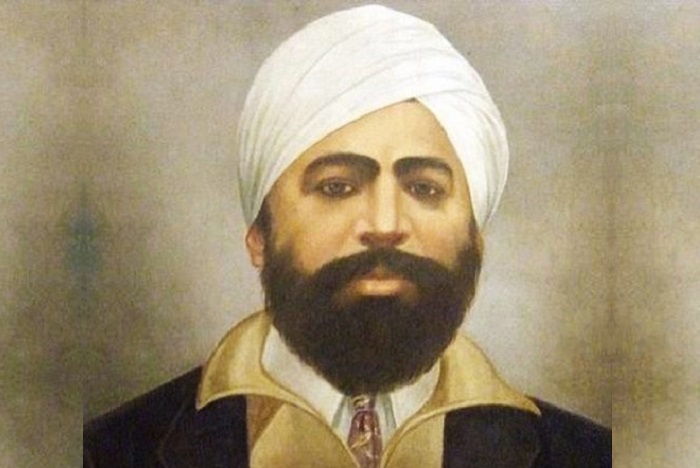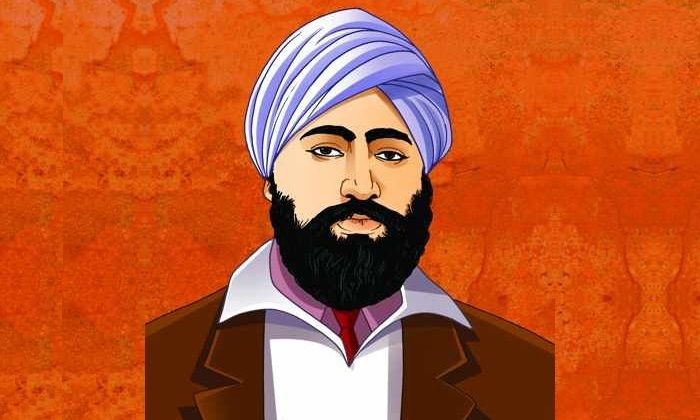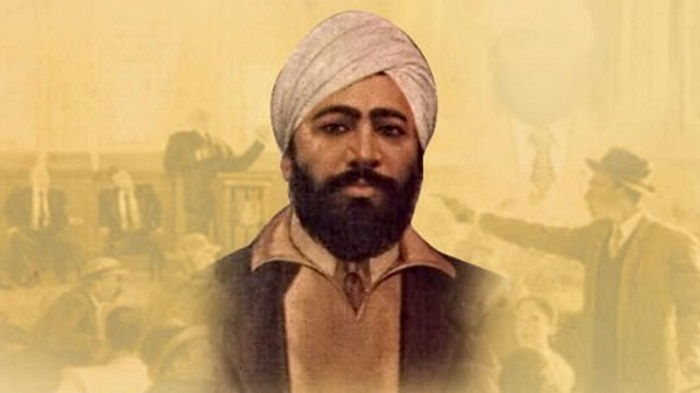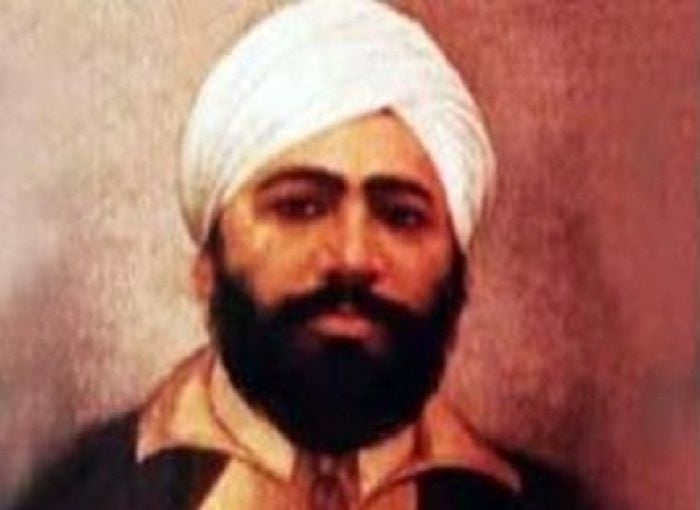Fast Facts
Born: 26 December 1899
Place of Birth: Village Sunam, Sangrur district, Punjab, India
Parents: Tehal Singh Kamboj (Father), Narain Kaur (Mother)
Political Association: Ghadar Party, Hindustan Socialist Republican Association
Political Ideology: Revolutionary
Death: 31 July 1940
Udham Singh was an Indian revolutionary and freedom fighter. He became popular when he assassinated Michael O’ Dwyer, the former Lieutenant Governor of the Punjab, who was responsible for the 1919 Jallianwala Bagh massacre. The carnage that Udham Singh witnessed left him deeply shocked and resentful, and it was only two decades later that he was able to avenge the deaths of hundreds of his innocent countrymen. For this singular act of bravery, Shaheed-i-Azam Sardar Udham Singh, as he is also popularly referred to, became famous in India and abroad. Arrested immediately after the incident, he was tried in Britain and hanged subsequently at London’s Pentonville prison in July 1940.

Image Credit : https://www.thebetterindia.com/95695/udham-singh-punjab-jallianwala-bagh-massacre/
Early Life
Udham Singh was born as Sher Singh on 26 December 1899 to a Kamboj family in village Sunam in the then princely state of Patiala (presently Sangrur district of Punjab, India). His father, Tahal Singh Kamboj, was then employed as a watchman at a railway crossing in Upali, another village in the neighbourhood. Sher Singh and his elder brother, Mukta Singh, lost their parents at an early age; their mother died in 1901, and their father followed in 1907, leaving the two brothers with no option but to seek admittance to the Central Khalsa Orphanage at Putlighar in Amritsar on 24 October 1907. At the orphanage, they were initiated into Sikhism and consequently received new names; Sher Singh became Udham Singh while his brother took on the name of Sadhu Singh. Tragically, Sadhu Singh also died just a decade later in 1917, leaving the 17-year-old Udham all alone in the world.
In 1918, Udham Singh passed his matriculation examination and left the orphanage for good the next year. At that time, there was intense political turmoil in Punjab and young Udham was no stranger to the many upheavals taking place all around him.
Jallianwala Bagh Massacre
Sunday, 13 April 1919 was the day of Baisakhi—a major Punjabi festival to celebrate the arrival of the New Year—and thousands of people from neighbouring villages had congregated in Amritsar for the usual festivities and fun fairs. After the closure of the cattle fair, many people started gathering together at Jallianwala Bagh a public garden of 6-7 acres that was walled on all the sides. Fearing that a major insurrection could take place at any time, Colonel Reginald Dyer had earlier banned all meetings, however, it was very unlikely that the general public knew of the ban. Upon hearing of the gathering at Jallianwala Bagh, Colonel Dyer marched with his troops, sealed off the exits, and ordered his men to fire indiscriminately at the men, women, and children. In the ten minutes of insanity before the ammunition got exhausted, there was complete mayhem and carnage. According to official British Indian sources, 379 people died and 1,100 were wounded, however, the Indian National Congress estimated the deaths to be over 1000 with 1,500 wounded. Initially, hailed as a hero by the conservatives in the British Empire, the British House of Commons, horrified with the brutality of the attack severely censured and disciplined Harry Dyer by removing from his appointment, passing over his promotion, and barring him from further employment in India.
On that fateful day, Udham Singh was serving drinking water to the congregation of people who had gathered together at Jallianwalla Bagh from the neighbouring villages for the Baisakhi festivities. According to some reports, even Udham Singh was wounded in the incident in his efforts to retrieve the body of one Rattan Devi’s husband. The shocking massacre of innocent people left the young and impressionable Udham Singh full of hatred for the British and from that day he would only think of ways of exacting retribution for this crime against humanity.

Image Credit : https://www.pustakmandi.com/shaheed-udham-singh
Involvement in Revolutionary Activities
Deeply scarred by the Jallianwala massacre and full of anger against the British, Udham Singh soon got involved in the freedom struggle that was then unfolding both in India and in foreign countries. He travelled to East Africa in the early 1920s working as a labourer before arriving in the USA. For some time, he even worked as a toolmaker at the factory of Ford in Detroit. While in San Francisco, he met up with the members of the Ghadar Party, which comprised of immigrant Punjabi-Sikhs who were conducting a revolutionary movement from the USA to free India from the tyrannical British rule. For the next few years, he travelled all over America to garner support for their activities assuming a number of aliases like Sher Singh, Ude Singh, and Frank Brazil.
In 1927, following the instructions of Bhagat Singh, he returned to India. Back in Punjab, he devoted himself to publishing the Ghadr-di-Gunj, the radical journal of Ghadar Party. He was arrested on this charge and for illegal possession of arms and sentenced to imprisonment for five years. However, he was released on 23 October 1931 after spending four years in jail. Udham Singh discovered that in 1927, Brigadier-General Dyer, “The Butcher of Amritsar”, had died in Britain, after suffering a series of strokes. His fellow revolutionaries, Bhagat Singh, Raj Guru, and Sukhdev had also been hanged on 23 March 1931 for their role in the murder of John P. Saunders, a British policeman, in 1928.
Udham Singh returned to his village but found himself under constant watch by the British police as he was known to have a very close association with Hindustan Socialist Republican Association established by Bhagat Singh and other revolutionaries. He took the name of Mohammed Singh Azad and became a painter of signboards under the cover of which, he continued his revolutionary activities and planned to travel to London to kill O’Dwyer who had endorsed the Jallianwala bloodbath.
He travelled to Kashmir and then escaped to Germany after duping the police. From there he successively travelled to Italy, France, Switzerland, and Austria before reaching England in 1934. He took up residence at 9 Adler Street, Whitechapel (East London) and even purchased a motor car. While in London, he worked in various capacities like a carpenter, signboard painter, motor mechanic, and even as an extra in a couple of Alexander Korda films. All this while he remained obsessed with the idea of assassinating Michael O’Dwyer.

Image Credit : http://www.freepressjournal.in/featured-blog/remembering-udham-singh-the-avenger-of-the-jallianwala-bagh-massacre/1050673
Assassination of Michael O’Dwyer
Udham Singh found out that Michael O’Dwyer would be addressing a joint meeting of Central Asian Society (now Royal Society for Asian Affairs) and the East India Association at Caxton Hall, London on 13 March 1940. He managed to buy a revolver in a pub from a soldier, concealed it in the pocket of his jacket and gained entry to the hall. As the meeting came to a close, he approached the platform and unleashed a volley of shots. Of the two shots that he fired at O’Dwyer, one passed through his heart and right lung killing him immediately. He also managed to wound Lord Zetland, the Secretary of State for India, Sir Luis Dane, and Lord Lamington.
After the shooting, Udham Singh remained calm and did not try to flee or resist arrest and was taken into custody by the police. It is said that Singh chose a public place for his assassination attempt so that he could create a furore and draw attention to the atrocities that the British had carried out in India.
Trial & Execution
Udham Singh was formally charged on 1 April 1940 with Michael O’Dwyer’s murder and sent to Brixton Prison. Not a cooperative prisoner, he went on a hunger strike that went on for 42 days compelling the prison authorities to forcibly feed him. Udham Singh was put on trial at the Central Criminal Court, Old Bailey on 4 June 1940 before Justice Atkinson. He was represented by legal luminaries like St. John Hutchinson and V.K. Krishna Menon. When asked why he committed the broad daylight murder, Udham Singh, in his broken English, stated that he bore a grudge against O’Dwyer and that he didn’t care about being put to death for the sake of his motherland. He further said that he had been seeking vengeance for 21 years and he was happy that he had finally managed to achieve his goal. He also expressed surprise that he failed to kill Zetland who deserved to die. He seemed to regret that he had managed to kill only one person.
As was expected, Singh was convicted of murder and awarded a death sentence. After he was convicted he made an impassioned speech which, however, was not allowed to be released to the press by the judge on the ground that it was not pertinent to the case. At the trial, Udham had given his name as Mohammad Singh Azad, the same name he had used to gain entry to England in 1933. The name was also tattooed on his arm as a symbol of the unity of all religions against the British oppression. On July 31, 1940, Udham Singh was hanged at the Pentonville Prison in London and was buried in the prison grounds.

Image Credit :https://naidunia.jagran.com/special-story-when-udham-singh-shot-michael-francis-odwyer-for-jallianwala-bagh-massacre-1603607
Repatriation of Remains
In 1974, more than three decades after his death, at the behest of MLA Sadhu Singh Thind Udham Singh’s mortal remains were exhumed and returned to India. The casket, brought back personally by Thind was received by Prime Minister Indira Gandhi, Giani Zail Singh, the then chief minister of Punjab, and Shankar Dayal Sharma, the then President of the Congress party. Subsequently, Udham Singh was cremated according to Sikh rites at Sunam, his birthplace, and his ashes were immersed in the waters of the River Sutlej. A part of the ashes was retained and are now kept in a sealed urn at Jallianwala Bagh.


